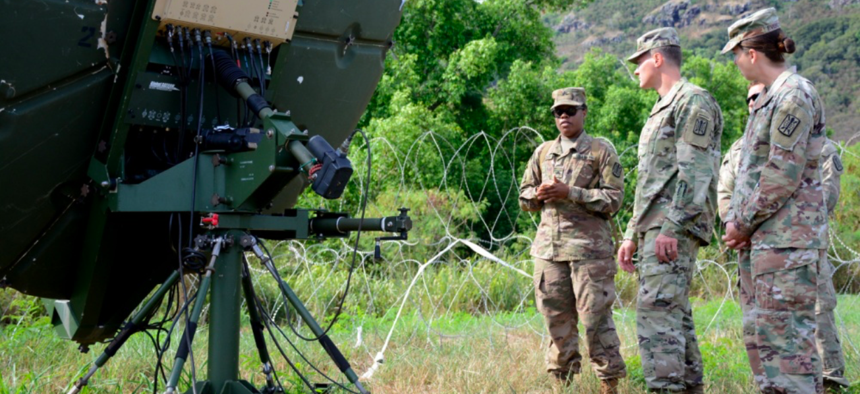
Sgt. Patricia Donaldson, a military systems maintainer/integrator assigned to 715th Military Intelligence Battalion, briefs colleagues on communications equipment during training exercise Lightning Forge on the Island of Oahu July 24, 2018. Sgt. Shameeka Stanley/Army
Military Intelligence Spending Just Posted Biggest Spike in a Decade
With an 18 percent increase this year, the Pentagon’s $22 billion intelligence tab is rising faster than civilian spy agencies.
Pentagon intelligence spending rose nearly 18 percent over the past year, a sign the military is ramping up its spying-and-intel-gathering activities around the world.
While military intelligence spending has risen between two and seven percent since 2016, the increase from $19.2 billion in fiscal 2017 to $22.1 billion in fiscal 2018 represents the largest annual spike since the Pentagon began releasing the figures a decade ago. (Defense One has adjusted all figures from then-year dollars to current 2018 values.)

“Current operations are a huge driver of intelligence spending,” said Travis Sharp, a defense spending analyst with the Center for Strategic and Budgetary Assessments. “The level of resources that’s dedicated to supporting [intelligence, surveillance and reconnaissance] activities is pretty substantial.”
By comparison, money spent on the National Intelligence Program — U.S. spy activities done outside of the military — increased about 6.7 percent in real terms between 2017 and 2018. Over that same period, the Pentagon’s total budget increased about 6 percent.
Pentagon officials do not publicly detail how they spend the billions they get for intelligence, citing a need for secrecy, but they do release two figures each year: How much they request and how much Congress approved.
Current military intelligence spending is increasing at a rate not seen since the high point of the wars in Iraq and Afghanistan, a time when hundreds of thousands of American troops were deployed. While there are substantially fewer troops on the ground in those two countries today, the military still relies on a vast intelligence network of people and drones over the battlefield.
Those drones — flown by a mix of troops and contractors — collect video and signals — which is reviewed by analysts and machines.
“That chain, from targeting to collection, to processing, to analysis, to dissemination — the intelligence cycle is expensive and manpower-intensive,” Sharp said.
Beyond combat operations in Syria, Iraq, Afghanistan, and Africa, other factors are fueling military intelligence spending.
The U.S. has boosted its spying on Russia since its 2014 invasion of Ukraine, the Washington Post reported in 2016. Then there are bureaucratic changes that could lead to spending increases.
“If they did any kind of reorganization, consolidation, if they moved something from the National Intelligence Program to the Military Intelligence Program, there might have been an internal cost transfer,” Sharp said.







